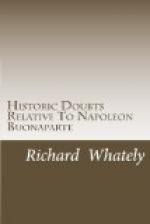[5] “With what greediness are the miraculous accounts of travellers received, their descriptions of sea and land monsters, their relations of wonderful adventures, strange men, and uncouth manners!”—Hume’s Essay on Miracles, p. 179, 12mo; p. 185, 8vo, 1767; p. 117, 8vo, 1817.
N.B.—In order to give every possible facility of reference, three editions of Hume’s Essays have been generally employed: a 12mo, London, 1756, and two 8vo editions.
[6] “Suppose a fact to be transmitted through twenty persons; the first communicating it to the second, the second to the third, &c., and let the probability of each testimony be expressed by nine-tenths, (that is, suppose that of ten reports made by each witness, nine only are true,) then, at every time the story passes from one witness to another, the evidence is reduced to nine-tenths of what it was before. Thus, after it has passed through the whole twenty, the evidence will be found to be less than one-eighth.”—LA PLACE, Essai Philosophique sur les Probabilites.
That is, the chances for the fact thus attested being true, will be, according to this distinguished calculator, less than one in eight. Very few of the common newspaper-stories, however, relating to foreign countries, could be traced, if the matter were carefully investigated, up to an actual eye-witness, even through twenty intermediate witnesses; and many of the steps of our ladder, would, I fear, prove but rotten; few of the reporters would deserve to have one in ten fixed as the proportion of their false accounts.
[7] “I did not mention the difficulty of detecting a falsehood in any private or even public history, at the time and place where it is said to happen; much more where the scene is removed to ever so small a distance.... But the matter never comes to any issue, if trusted to the common method of altercation and debate and flying rumours.”—Hume’s Essay on Miracles, p. 195, 12mo; pp. 200, 201, 8vo, 1767; p. 127, 8vo, 1817.
[8] See the third Postscript appended to this edition.
[9] “We entertain a suspicion concerning any matter of fact, when the witnesses contradict each other; when they are of a suspicious character; when they have an interest in what they affirm.”—Hume’s Essay on Miracles, p. 172, 12mo; p. 176, 8vo, 1767; p. 113, 8vo. 1817.
[10] “That testimony itself derives all its force from experience, seems very certain.... The first author, we believe, who stated fairly the connexion between the evidence of testimony and the evidence of experience, was HUME, in his Essay on Miracles, a work ... abounding in maxims of great use in the conduct of life.”—Edin. Review, Sept. 1814, p. 328.
[11] “Suppose, for instance, that the fact which the testimony endeavours to establish partakes of the extraordinary and the marvellous; in that case, the evidence resulting from the testimony receives a diminution, greater or less in proportion as the fact is more or less unusual.”—Hume’s Essay on Miracles, p. 173, 12mo; p. 176, 8vo, 1767; p. 113, 8vo, 1817.




